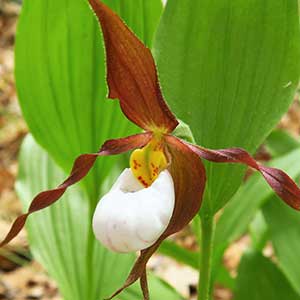Cypripedium montanum
Cypripedium arietinum
mountain lady slipper, mountain lady's-slipper, white lady's-slipper
cypripède tête-de-bélier, ram's-head, ram's-head lady's-slipper
4–6, inserted toward base or scattered along stem, alternate, erect, ascending, or spreading;
blade suborbiculate or broadly ovate to elliptic-lanceolate, 3.3–17 × 2.5–9.5 cm.
3–4, along middle portion of stem, spiraled to alternate, ascending to spreading;
blade narrowly elliptic to ovate-lanceolate or oblong, 5–11 × 1.3–3.5 cm.
1–3;
sepals greenish, suffused, often heavily, with reddish brown or madder, or rarely clear green;
dorsal sepal lance-acuminate to elliptic-lance-acuminate, 33–60 × 8–16 mm;
lateral sepals connate;
synsepal 30–60 × 6–18 mm;
petals spreading-deflexed, same color as sepals, spirally twisted, linear to linear-lanceolate, 36–77 × 3–5 mm;
lip white, rarely suffused with magenta, obovoid or oblance-ovoid to oblance-fusiform, 19–33 mm;
orifice basal, 13–22 mm;
staminode lanceoloid to broadly ovoid or ellipsoid-ovoid.
usually solitary (rarely 2 in forma biflorum P.
.
);
sepals green with reddish brown markings;
dorsal sepal broadly elliptic to ovate-lanceolate, 15–25 × 5–10 mm;
lateral sepals distinct, 12–20 × 1.5–4 mm;
petals somewhat spreading, same color as sepals, somewhat spirally twisted, linear- to linear-lanceolate, 11–24 × 1–2 mm;
lip white with green apex, usually with extensive reddish reticulations often merging toward apex, adaxially swollen near middle, 10–16 mm, apex abruptly deflected downward, orifice basal, 7–12 mm;
staminode suborbicular.
= 20.
Cypripedium montanum
Cypripedium arietinum
Plants of Cypripedium montanum grown in exposed, relatively sunny situations have the ascending leaves inserted along the basal portion of the stem and the flowers displayed well above the leaves. In shadier, especially sheltered sites, the spreading leaves may be more evenly scattered along the stem. In this species the apical margin of the orifice of the lip is usually acute, in common with C. candidum, and in contrast to the usually obtuse margin in C. parviflorum; this difference can aid determination of discolored herbarium specimens. Hybrids of C. montanum and C. parviflorum have been designated C. ×columbianum Sheviak. See 11. C. parviflorum for a general discussion of hybridization and variation within and between related species.
(Discussion copyrighted by Flora of North America; reprinted with permission.)
- Local floras:
BC,
CA,
OR,
WA
- Local Web sites:
CalFlora,
CalPhotos,
Flora NW,
PNW Herbaria,
Turner Photog.
WildflowerSearch
iNaturalist (observations)
USDA Plants Database
- LBJ Wildflower Center
- SEINet
- Plants of the World Online
- Encyclopedia of Life
- Wikipedia
- Google Image Search


